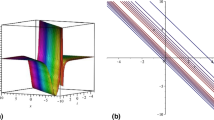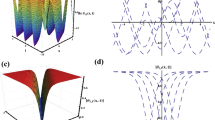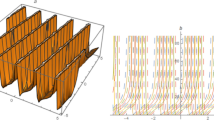Abstract
In this paper, the extended (3+1)-dimensional cubic Schrödinger equation (3D-CNLSE) describes the propagation of pulses in highly nonlinear optical systems solved by the generalized Jacobi elliptic function expansion method. Many novel periodic, hyperbolic, and trigonometric function wave solutions are obtained. The obtained solutions recover some other solutions obtained in the literature and add other new solutions for it. Moreover, the resulting solitary wave solutions can take many different shapes like periodic, kink soliton, and bright solitons. To illustrate the dynamics of the different solitary wave solutions we have chosen to plot the periodic and the kink wave solutions in a medium with self-focusing Kerr-nonlinearity and the bright soliton wave in a medium with self-defocusing nonlinearity every wave was drowned in the 3D, Density, and 2D and it was clear that the solitary wave shape is affected by the choices of the parameters represented the medium.
Similar content being viewed by others
Avoid common mistakes on your manuscript.
1 Introduction
Nowadays, the nonlinear Schrödinger equation (NLSE) becomes an important model in numerous fields of science like quantum mechanics, nonlinear optics, ocean dynamics, plasma physics, etc. (El-Shiekh 2019; El-Shiekh and Gaballah 2021a, 2020a, b, c; El-Shiekh and Hamdy 2023; Gaballah et al. 2022).
Currently, the higher dimensional NLSE has attracted much attention since the high-dimensional NLSE model is more realistic and plentiful due to the increase of dimension. Moreover, other difficulties can be found by increasing the nonlinear terms like in the cubic and higher-order nonlinear Schrödinger equation which demonstrate the propagation of optical pulses in highly nonlinear optical systems (Alamri et al. 2019; Cheemaa et al. 2018; Li and Ma 2020; Wang 2021; Wazwaz 2021; Wazwaz and Mehanna 2021).
Recently, (Wang 2021) has introduced a new extended (3+1)-dimensional cubic NLSE built on the extended (3 + 1)-dimensional zero curvature equation as follows:
Then, (Wazwaz and Mehanna 2021) generalized the extended (3+1)-dimensional cubic NLSE (1) in the following form:
where \(\varphi (x,y,z,t)\) is the complex envelope of the wave and x, y, z are the spatial variables, where t is the temporal variable, also \(p_{j},q_{j},\) where \(j=1,2,3\) are constants and \(r=\pm 1\) is a parameter may representing self-focusing Kerr and self-defocusing nonlinearity, respectively. Equation (2) can be used to describe the pulse propagation in nonlinear optical fibers (Wang 2021; Wazwaz 2021; Wazwaz and Mehanna 2021).
From the previous importance of the extended (3+1)-dimensional cubic NLSE especially in the optics field, we are going to drive novel wave solutions for this equation using the generalized Jacobi elliptic function expansion (GJEE) method. The investigated solutions have different waveforms like kink, soliton, and periodic shapes and to discuss the novelty of the obtained solutions we will plot them in different structures and compare them with other obtained solutions before
2 Methodology
Nonlinear differential equations (NLDE) have an immense number of applications in numerous fields, especially in physics where they find widespread use in magnetohydrodynamics, ferrohydrodynamics, hydrostatic gravity waves, as well as the study of the electromagnetic spectrum, photons, and many other fields. To obtain exact solitary wave solutions to advanced NLDE that cause great concern in both physicists and mathematicians. These solutions are used to describe complex physical phenomena and dynamics, such as periodic wave solutions, solitons solutions, elliptic function solutions, dark solitary waves of the solution, and kink solitary waves of a solution, several methods have been constructed for this purpose, like the homogenous balance method, Hirota’s bilinear method, the hyperbolic function expansion method, auxiliary method, the sine cosine method, the Kudryashov method, the nonlinear transformation method, extended direct algebraic method and the trial function method (Cheemaa et al. 2019; El-Sayed et al. 2014; El-Shiekh et al. 2022; El-Shiekh 2021, 2018b, c, a, 2015; El-Sayed 2013; El-Shiekh et al. 2022; El-Shiekh and Gaballah 2023b, a; El-Shiekh et al. 2022; El-Shiekh and Gaballah 2021b; Gaballah et al. 2023; Li and Ma 2023b, a, 2022b, a, 2018, 2017; Ma et al. 2009, 2018; Ma and Li 2023; Moatimid et al. 2013; Seadawy 2016; Seadawy et al. 2019, 2018; Zkan et al. 2020). One of these powerful techniques is the generalized Jacobi elliptic function expansion technique (Gaballah et al. 2023, 2022; Zayed and Alngar 2020). In the following the main steps of the GJEE method:
Step1: Consider a nonlinear partial differential equation (NPDE)
where \(\varphi =\varphi \left( x,y,z,t\right)\) is a complex function and x, y, z are the spatial variables and t is the temporal variable.
Step2: Use the following traveling wave transformation to transform Eq. (2) into a nonlinear ordinary equation (NODE)
where \(k_{1},k_{2},k_{3},\) \(\alpha ,\beta ,\gamma ,c_{1}\) and \(c_{2}\) are real constants and \(\Phi\) is a real function on the wave variable \(\xi .\) Now, consider the new obtained NODE has a solution in the form:
where M is a positive integer determined from the balance procedure applied to the obtained NODE, \(A_{l},B_{l}\ (l=0,1,......,M)\)are real constants to be determined and \(\phi (\xi )\) satisfies the Jacobi elliptic function equation
where \(a_{0}\), \(a_{2},\) and \(a_{4}\) are parameters that have known values (Zayed and Alngar 2020). By inserting Eq. (6) and Eq. (7) into the obtained NODE after using the traveling wave transformation in Eq. (5) and by collecting different powers of \(\phi\) and \(\phi ^{\prime }\) equating it by zero, then an algebraic system is yielded, and by solving it the constants \(A_{l},B_{l}\) are determined. Finally, from the known values of the constants \(a_{0},a_{2},\) and \(a_{4}\) different functions like hyperbolic and periodic wave functions are arisen.
3 Novel wave solutions for the extended 3D-CNLSE
By inserting Eq. (4) and Eq. (5) into Eq. (2), considering the real and imaginary parts are separate, we get the real part as:
The imaginary part:
Assume that the imaginary part is finished so we have the following condition on the constants
Then, Eq. (8) becomes
where
Now, we are going to solve Eq. (11) by using the GJEE method. Make the balance between the linear term \(\Phi ^{\prime \prime }\) and the nonlinear term \(\Phi ^{3}\) lead to \(M=1\) so that \(\Phi\) can be put in the form:
where \(\phi (\xi )\) verifying Eq. (7). By substituting Eq. (13) into Eq. (11) using Eq. (7), collecting the coefficients of \(\phi (\xi )\) and \(\phi ^{\prime }(\xi )\) and equating it with zero the following algebraic system is yielded:2
System (14) is solved by the Maple program, and two different cases of solutions are given:
Case I: \(A_{1}=\pm \sqrt{\frac{-2a_{4}}{\mu }},A_{0}=B_{0}=B_{1}=0,\lambda =-a_{2}.\)
Novel Jacobi function solutions are yielded for the extended 3D-CNLSE equation as follows:
Group I:
where \(\lambda <1\) in most of the above Jacobi solutions.
If the modulus of the Jacobi elliptic function approches to 1, the hyperbolic functions arise as:
Group II:
If the modulus of the Jacobi elliptic function approches to 0, the triagnometric functions arise as:
Group III:
Case II: \(\lambda =2a_{2},B_{0}=\pm \sqrt{\frac{-2}{\mu }},A_{0}=A_{1}=B_{1}=0.\)
By using the second case of solutions obtained for the algebric system (14), the follwoing novel Jacobi function solutions are created:
Group IV:
4 Results and discussion
Many natural phenomena can be described by nonlinear waves, so they exist in different fields of science as optics, hydrodynamics, plasma physics, etc. Nonlinear waves have two different types: solitary waves in a dispersion medium and waves in a dissipative dispersion medium. Solitons are nonlinear solitary waves that keep their shape according to propagation without change so it is very important and has many applications in physical science especially in optics. In this study many types of solitary waves are obtained therefore, in this section, we are going to plot three different solitary shapes, as an example of the change in the nonlinear wave behavior from one solitary wave solution to another as follows:
The different plots for the periodic solitary wave \(\left| \varphi _{1}\right| ^{2}\) through optical fiber, when \(p_{1}=0.5,p_{2}=p_{3}=k_{1}=k_{2}=k_{3}=q_{1}=q_{2}=q_{3}=\alpha =\beta =\gamma =r=1,c_{2}=-1\) and the values of \(c_{1}=-2\), \(\lambda =3,\) and \(\mu =-2\) according to equations (10) and (12). Moreover, the dimensions \(y=z=0\) but \(x\in [-10,10]\) and \(t\in [0,10]\) in figures (1-a) and (2-b), where \(t=1,2,3\) correspond to the blue, orange, and green lines respectively
The different graphs of the optical kink soliton \(\left| \varphi _{16}\right| ^{2}\) in 3D, density, 2D respectively, where y=z=0 and the parameters are taken as: \(p_{1}=0.5,p_{2}=p_{3}=k_{1}=k_{2}=k_{3}=q_{1}=q_{2}=q_{3}=\alpha =\beta =\gamma =r=1,c_{2}=-1.5.\) Therefore, from Eqs. (10) and (12), \(c_{1}=-2\), \(\lambda =2,\) and \(\mu =-2,\) and hence, the periodic wave solution given by Eq. (15) transformed to the kink soliton solution \(\varphi _{16}\) given by Eq. (30). The graphs are in x range \(0\le x\le 10\) for all Fig. 2, and t range \(0\le t\le 5\) while the 2D lines are for the t values 1, 2, 3 respectively
The 3D, density, and 2D plots for the bright optical soliton \(\left| \varphi _{17}\right| ^{2}\) where the constants are \(p_{1}=0.5,p_{2}=p_{3}=k_{1}=k_{2}=k_{3}=q_{1}=q_{2}=q_{3}=\alpha =\beta =\gamma =1,r=-1,c_{2}=-3\). So that, the other dependent constants are \(c_{1}=-2,\lambda =-1,\) and \(\mu =2,\) where \(y=z=0\), and \(x\in [0,10]\) and \(t\in [0,5]\)
In Figs. 1 and 2, the periodic and kink soliton wave solutions were derived in a medium with self-focusing Kerr-nonlinearity as \(r=1\), but the bright soliton wave solution represented in Fig. 3 is driven in a medium with self-defocusing nonlinearity and it is clear that by changing the values of the parameters the soliton shape is changing and the dynamic behavior of the wave is affected.
5 Conclusion
In this paper, the extended 3D CNLSE was investigated by the GJEE method and according to that many distinct solitary wave solutions were obtained in the form of Jacobi elliptic functions, hyperbolic functions, and trigonometric functions. The obtained solutions covered some obtained solutions in the literature and there are many other novel solutions (Wang 2021; Wazwaz 2021; Wazwaz and Mehanna 2021). From the results, we can conclude that the GJEE is an effective, simple method and can be valid for other complicated complex systems. Moreover, the propagation of periodic, kink, and bright solitons was discussed in two different mediums self-focusing Kerr-nonlinearity and self-defocusing nonlinearity which have important applications in nonlinear optics.
Data Availability
There is no data set need to be accessed
References
Alamri, S.Z., Seadawy, A.R., Al-Sharari, H.M.: Study of optical soliton fibers with power law model by means of higher-order nonlinear Schrö dinger dynamical system. Results Phys. 13, 102251 (2019). https://doi.org/10.1016/J.RINP.2019.102251
Cheemaa, N., Seadawy, A.R., Chen, S.: More general families of exact solitary wave solutions of the nonlinear Schrödinger equation with their applications in nonlinear optics. Eur. Phys. J. Plus. 13312(133), 1–9 (2018). https://doi.org/10.1140/EPJP/I2018-12354-9
Cheemaa, N., Seadawy, A.R., Chen, S.: Some new families of solitary wave solutions of the generalized Schamel equation and their applications in plasma physics. Eur. Phys. J. Plus. 1343(134), 1–9 (2019). https://doi.org/10.1140/EPJP/I2019-12467-7
El-Sayed, M.F., Moatimid, G.M., Moussa, M.H.M., El-Shiekh, R.M., El-Satar, A.A.: Symmetry group analysis and similarity solutions for the (2+1)-dimensional coupled Burger’s system. Math. Methods Appl. Sci. 37(8), 1113–1120 (2014). https://doi.org/10.1002/mma.2870
El-Shiekh, R.M.: New exact solutions for the variable coefficient modified KdV equation using direct reduction method. Math. Methods Appl. Sci. 36(1), 1–4 (2013). https://doi.org/10.1002/mma.2561
El-Shiekh, R.M.: Direct similarity reduction and new exact solutions for the variable-coefficient kadomtsev–petviashvili equation. Zeitschrift fur Naturforsch. Sect. A J. Phys. Sci. 70(6), 445–450 (2015). https://doi.org/10.1515/zna-2015-0057
El-Shiekh, R.M.: New similarity solutions for the generalized variable-coefficients KdV equation by using symmetry group method. Arab J. Basic Appl. Sci. 25(2), 6670 (2018). https://doi.org/10.1080/25765299.2018.1449343
El-Shiekh, R.M.: Jacobi elliptic wave solutions for two variable coefficients cylindrical Korteweg-de Vries models arising in dusty plasmas by using direct reduction method. Comput. Math. Appl. 75(5), 1676–1684 (2018). https://doi.org/10.1016/j.camwa.2017.11.031
El-Shiekh, R.M.: Painlevé Test, Bäcklund transformation and consistent Riccati expansion solvability for two generalised Cylindrical Korteweg-de Vries equations with variable coefficients. Zeitschrift fur Naturforsch. Sect. A J. Phys. Sci. 73(3), 207–213 (2018). https://doi.org/10.1515/zna-2017-0349
El-Shiekh, R.M.: Classes of new exact solutions for nonlinear Schrö dinger equations with variable coefficients arising in optical fiber. Results Phys. 13, 102214 (2019). https://doi.org/10.1016/j.rinp.2019.102214
El-Shiekh, R.M.: Novel solitary and shock wave solutions for the generalized variable-coefficients (2+1)-dimensional KP-Burger equation arising in dusty plasma. Chin. J. Phys. 71, 341–350 (2021). https://doi.org/10.1016/J.CJPH.2021.03.006
El-Shiekh, R.M., Al-Nowehy, A.G.A.A.H.: Symmetries, reductions and different types of travelling wave solutions for symmetric coupled burgers equations. Int. J. Appl. Comput. Math. 84(8), 1–13 (2022). https://doi.org/10.1007/S40819-022-01385-3
El-Shiekh, R.M., Gaballah, M.: Bright and dark optical solitons for the generalized variable coefficients nonlinear Schrödinger equation. Int. J. Nonlinear Sci. Numer. Simul. 21(7–8), 675–681 (2020). https://doi.org/10.1515/ijnsns-2019-0054
El-Shiekh, R.M., Gaballah, M.: Solitary wave solutions for the variable-coefficient coupled nonlinear Schrödinger equations and Davey-Stewartson system using modified sine-Gordon equation method. J. Ocean Eng. Sci. 5(2), 180–185 (2020). https://doi.org/10.1016/j.joes.2019.10.003
El-Shiekh, R.M., Gaballah, M.: Novel solitons and periodic wave solutions for Davey-Stewartson system with variable coefficients. J. Taibah Univ. Sci. 14, 783–789 (2020). https://doi.org/10.1080/16583655.2020.1774975
El-Shiekh, R.M., Gaballah, M.: New rogon waves for the nonautonomous variable coefficients Schrödinger equation. Opt. Quantum Electron. 53, 1–12 (2021). https://doi.org/10.1007/S11082-021-03066-9/FIGURES/3
El-Shiekh, R.M., Gaballah, M.: New analytical solitary and periodic wave solutions for generalized variable-coefficients modified KdV equation with external-force term presenting atmospheric blocking in oceans. J. Ocean Eng. Sci. 7(4), 372–376 (2021). https://doi.org/10.1016/J.JOES.2021.09.003
El-Shiekh, R.M., Gaballah, M.: Integrability, similarity reductions and solutions for a (3+1)-dimensional modified Kadomtsev-Petviashvili system with variable coefficients. Partial Differ. Equations Appl. Math. 6, 100408 (2022). https://doi.org/10.1016/J.PADIFF.2022.100408
El-Shiekh, R.M., Gaballah, M.: Lie group analysis and novel solutions for the generalized variable-coefficients Sawada-Kotera equation. Europhys. Lett. (2023). https://doi.org/10.1209/0295-5075/ACB460
El-Shiekh, R.M., Gaballah, M., Elelamy, A.F.: Similarity reductions and wave solutions for the 3D-Kudryashov-Sinelshchikov equation with variable-coefficients in gas bubbles for a liquid. Results Phys. 40, 105782 (2022). https://doi.org/10.1016/J.RINP.2022.105782
El-Shiekh, R.M., Hamdy, H.: Novel distinct types of optical solitons for the coupled Fokas-Lenells equations. Opt. Quantum Electron. 55, 1–11 (2023). https://doi.org/10.1007/S11082-023-04546-W/METRICS
Gaballah, M., El-Shiekh, R.M.: Similarity reduction and multiple novel travelling and solitary wave solutions for the two-dimensional Bogoyavlensky-Konopelchenko equation with variable coefficients. J. Taibah Univ. Sci. 17, 2192280 (2023). https://doi.org/10.1080/16583655.2023.2192280
Gaballah, M., El-Shiekh, R.M., Akinyemi, L., Rezazadeh, H.: Novel periodic and optical soliton solutions for Davey-Stewartson system by generalized Jacobi elliptic expansion method. Int. J. Nonlinear Sci. Numer. Simul. (2022). https://doi.org/10.1515/ijnsns-2021-0349
Gaballah, M., El-Shiekh, R.M., Hamdy, H.: Generalized periodic and soliton optical ultrashort pulses for perturbed Fokas-Lenells equation. Opt. Quantum Electron. 55, 1–12 (2023). https://doi.org/10.1007/S11082-023-04644-9/METRICS
Li, B.Q., Ma, Y.L.: Periodic solutions and solitons to two complex short pulse (CSP) equations in optical fiber. Optik (Stuttg). 144, 149–155 (2017). https://doi.org/10.1016/J.IJLEO.2017.06.114
Li, B.Q., Ma, Y.L.: Loop-like periodic waves and solitons to the Kraenkel-Manna-Merle system in ferrites. J. Electromagn. Waves Appl. 32, 1275–1286 (2018). https://doi.org/10.1080/09205071.2018.1431156
Li, B.Q., Ma, Y.L.: Extended generalized Darboux transformation to hybrid rogue wave and breather solutions for a nonlinear Schrödinger equation. Appl. Math. Comput. 386, 125469 (2020). https://doi.org/10.1016/J.AMC.2020.125469
Li, B.Q., Ma, Y.L.: Interaction properties between rogue wave and breathers to the manakov system arising from stationary self-focusing electromagnetic systems. Chaos Solitons & Fractals. 156, 111832 (2022). https://doi.org/10.1016/J.CHAOS.2022.111832
Li, B.Q., Ma, Y.L.: Soliton resonances and soliton molecules of pump wave and Stokes wave for a transient stimulated Raman scattering system in optics. Eur. Phys. J. Plus. 13711(137), 1–14 (2022). https://doi.org/10.1140/EPJP/S13360-022-03455-3
Li, B.Q., Ma, Y.L.: A ‘firewall’ effect during the rogue wave and breather interactions to the Manakov system. Nonlinear Dyn. 111, 1565–1575 (2023). https://doi.org/10.1007/S11071-022-07878-6/METRICS
Li, B.Q., Ma, Y.L.: Optical soliton resonances and soliton molecules for the Lakshmanan-Porsezian-Daniel system in nonlinear optics. Nonlinear Dyn. 111, 6689–6699 (2023). https://doi.org/10.1007/S11071-022-08195-8/METRICS
Ma, Y., Li, B., Wang, C.: A series of abundant exact travelling wave solutions for a modified generalized Vakhnenko equation using auxiliary equation method. Appl. Math. Comput. 211, 102–107 (2009). https://doi.org/10.1016/J.AMC.2009.01.036
Ma, Y.L., Li, B.Q.: Soliton resonances for a transient stimulated Raman scattering system. Nonlinear Dyn. 111, 2631–2640 (2023). https://doi.org/10.1007/S11071-022-07945-Y/METRICS
Ma, Y.L., Li, B.Q., Fu, Y.Y.: A series of the solutions for the Heisenberg ferromagnetic spin chain equation. Math. Methods Appl. Sci. 41, 3316–3322 (2018). https://doi.org/10.1002/MMA.4818
Moatimid, G.M., El-Shiekh, R.M., Al-Nowehy, A.-G.A.A.H.: Exact solutions for Calogero-Bogoyavlenskii-Schiff equation using symmetry method. Appl. Math. Comput. 220, 455–462 (2013). https://doi.org/10.1016/j.amc.2013.06.034
Stability Analysis of Traveling Wave Solutions for Generalized Coupled Nonlinear KdV Equations. Appl. Math. Inf. Sci. 10, 209–214 (2016). https://doi.org/10.18576/amis/100120
Seadawy, A.R., Arshad, M., Lu, D.: Modulation stability analysis and solitary wave solutions of nonlinear higher-order Schrödinger dynamical equation with second-order spatiotemporal dispersion. Indian J. Phys. 93, 1041–1049 (2019). https://doi.org/10.1007/S12648-018-01361-Y/FIGURES/5
Seadawy, A.R., Kumar, D., Hosseini, K., Samadani, F.: The system of equations for the ion sound and Langmuir waves and its new exact solutions. Results Phys. 9, 1631–1634 (2018). https://doi.org/10.1016/J.RINP.2018.04.064
Wang, G.: A new (3 + 1)-dimensional Schrödinger equation: derivation, soliton solutions and conservation laws. Nonlinear Dyn. 104, 1595–1602 (2021). https://doi.org/10.1007/S11071-021-06359-6/METRICS
Wazwaz, A.M.: Bright and dark optical solitons for (3+1)-dimensional Schrödinger equation with cubic-quintic-septic nonlinearities. Optik (Stuttg). 225, 165752 (2021). https://doi.org/10.1016/J.IJLEO.2020.165752
Wazwaz, A.M., Mehanna, M.: Bright and dark optical solitons for a new (3+1)-dimensional nonlinear Schrödinger equation. Optik (Stuttg). 241, 166985 (2021). https://doi.org/10.1016/J.IJLEO.2021.166985
Zayed, E.M.E., Alngar, M.E.M.: Optical solitons in birefringent fibers with Biswas-Arshed model by generalized Jacobi elliptic function expansion method. Optik (Stuttg). 203, 163922 (2020). https://doi.org/10.1016/J.IJLEO.2019.163922
Zkan, Y.S., Yaşar, E., Seadawy, A.R.: On the multi-waves, interaction and Peregrine-like rational solutions of perturbed Radhakrishnan-Kundu-Lakshmanan equation. Phys. Scr. 95, 085205 (2020). https://doi.org/10.1088/1402-4896/AB9AF4
Acknowledgements
The authors would like to thank the Deanship of Scientific Research, Majmaah University, Saudi Arabia, for funding this work under project No. R-2023-437.
Funding
The project is funded under project No. R-2023-437
Author information
Authors and Affiliations
Contributions
RME made calculations for methodology and reviewed the manuscript and Mahmoud Gaballah wrote and made necessary applications and figures.
Corresponding author
Ethics declarations
Conflict of interest
There is no compact of interest.
Ethical approval
There’s no data need to ethical approval.
Additional information
Publisher's Note
Springer Nature remains neutral with regard to jurisdictional claims in published maps and institutional affiliations.
Rights and permissions
Springer Nature or its licensor (e.g. a society or other partner) holds exclusive rights to this article under a publishing agreement with the author(s) or other rightsholder(s); author self-archiving of the accepted manuscript version of this article is solely governed by the terms of such publishing agreement and applicable law.
About this article
Cite this article
El-Shiekh, R.M., Gaballah, M. Novel solitary and periodic waves for the extended cubic (3+1)-dimensional Schrödinger equation. Opt Quant Electron 55, 679 (2023). https://doi.org/10.1007/s11082-023-04965-9
Received:
Accepted:
Published:
DOI: https://doi.org/10.1007/s11082-023-04965-9







